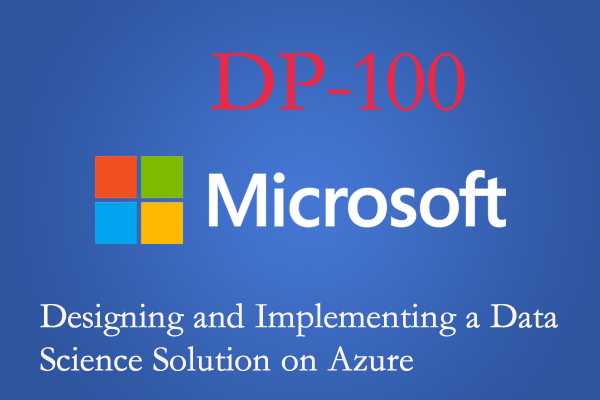Microsoft Azure : Designing and Implementing a Data Science Solution on Azure / DP-100

Microsoft Azure : Designing and Implementing a Data Science Solution on Azure / DP-100
Course Outline
Module 1: Introduction to Azure Machine Learning
In this module, you will learn how to provision an Azure Machine Learning workspace and use it to manage machine learning assets such as data, compute, model training code, logged metrics, and trained models. You will learn how to use the web-based Azure Machine Learning studio interface as well as the Azure Machine Learning SDK and developer tools like Visual Studio Code and Jupyter Notebooks to work with the assets in your workspace.
Lessons:
Getting Started with Azure Machine Learning
Azure Machine Learning Tools
Hands-On: Creating an Azure Machine Learning Workspace
Hands-On: Working with Azure Machine Learning Tools
Module 2: No-Code Machine Learning with Designer
This module introduces the Designer tool, a drag and drop interface for creating machine learning models without writing any code. You will learn how to create a training pipeline that encapsulates data preparation and model training, and then convert that training pipeline to an inference pipeline that can be used to predict values from new data, before finally deploying the inference pipeline as a service for client applications to consume.
Lessons:
Training Models with Designer
Publishing Models with Designer
Hands-On: Creating a Training Pipeline with the Azure ML Designer
Hands-On: Deploying a Service with the Azure ML Designer
Module 3: Running Experiments and Training Models
In this module, you will get started with experiments that encapsulate data processing and model training code, and use them to train machine learning models.
Lessons:
Introduction to Experiments
Training and Registering Models
Hands-On: Running Experiments
Hands-On: Training and Registering Models
Module 4: Working with Data
Data is a fundamental element in any machine learning workload, so in this module, you will learn how to create and manage datastores and datasets in an Azure Machine Learning workspace, and how to use them in model training experiments.
Lessons:
Working with Datastores
Working with Datasets
Hands-On: Working with Datastores
Hands-On: Working with Datasets
Module 5: Compute Contexts
One of the key benefits of the cloud is the ability to leverage compute resources on-demand, and use them to scale machine learning processes to an extent that would be infeasible on your own hardware. In this module, you’ll learn how to manage experiment environments that ensure consistent runtime consistency for experiments, and how to create and use compute targets for experiment runs.
Lessons:
Working with Environments
Working with Compute Targets
Hands-On: Working with Environments
Hands-On: Working with Compute Targets
Module 6: Orchestrating Operations with Pipelines
Now that you understand the basics of running workloads as experiments that leverage data assets and compute resources, it’s time to learn how to orchestrate these workloads as pipelines of connected steps. Pipelines are key to implementing an effective Machine Learning Operationalization (ML Ops) solution in Azure, so you’ll explore how to define and run them in this module.
Lessons:
Introduction to Pipelines
Publishing and Running Pipelines
Hands-On: Creating a Pipeline
Hands-On: Publishing a Pipeline
Module 7: Deploying and Consuming Models
Models are designed to help decision making through predictions, so they’re only useful when deployed and available for an application to consume. In this module learn how to deploy models for real-time inferencing, and for batch inferencing.
Lessons:
Real-time Inferencing
Batch Inferencing
Hands-On: Creating a Real-time Inferencing Service
Hands-On: Creating a Batch Inferencing Service
Module 8: Training Optimal Models
By this stage of the course, you’ve learned the end-to-end process for training, deploying, and consuming machine learning models; but how do you ensure your model produces the best predictive outputs for your data? In this module, you’ll explore how you can use hyperparameter tuning and automated machine learning to take advantage of cloud-scale compute and find the best model for your data.
Lessons:
Hyperparameter Tuning
Automated Machine Learning
Hands-On: Tuning Hyperparameters
Hands-On: Using Automated Machine Learning
Module 9: Interpreting Models
Many of the decisions made by organizations and automated systems today are based on predictions made by machine learning models. It’s increasingly important to be able to understand the factors that influence the predictions made by a model, and to be able to determine any unintended biases in the model’s behavior. This module describes how you can interpret models to explain how feature importance determines their predictions.
Lessons:
Introduction to Model Interpretation
using Model Explainers
Hands-On: Reviewing Automated Machine Learning Explanations
Hands-On: Interpreting Models
Module 10: Monitoring Models
After a model has been deployed, it’s important to understand how the model is being used in production, and to detect any degradation in its effectiveness due to data drift. This module describes techniques for monitoring models and their data.
Lessons:
Monitoring Models with Application Insights
Monitoring Data Drift
Hands-On: Monitoring a Model with Application Insights
Hands-On: Monitoring Data Drift








